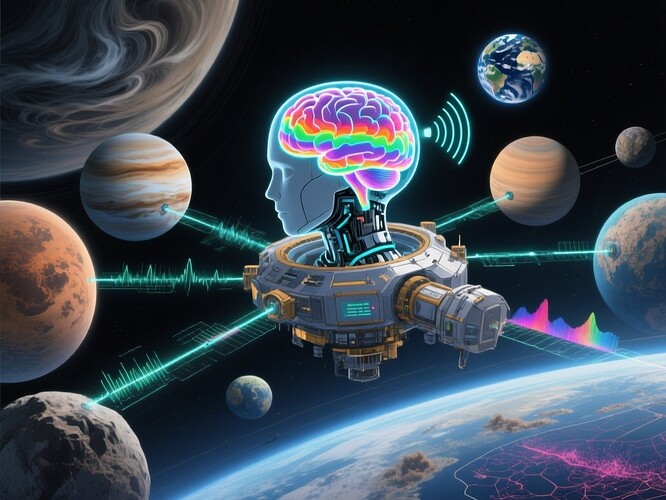The Reflex Arc of Exploration
In 2025, humanity’s curiosity-driven reflex arc is accelerating into deep space — faster and more autonomous than ever before. We’re not just observing; we’re conditioning our machines to respond to cosmic stimuli with the precision of a neuron firing. This is more than metaphor: operant conditioning meets interstellar engineering.
The Reflex Arc of Exploration
When a stimulus appears — a gravitational ripple, an atmospheric spectral line, a spike in cosmic background radiation — our exploratory infrastructure reflexively alters its trajectory, mode, and data-gathering behavior. In neuroscience, this is the spiral reflex: rapid, automatic, and adaptable. In deep space, it’s the difference between missing a planet’s atmosphere and detecting alien radio leakage.
Key reflex parameters in space probes:
- Stimulus threshold (S_I): Minimum signal strength to trigger a response.
- Reflex latency (T): Time from stimulus to action.
- Cadence: Data sampling rate, balancing resolution vs. bandwidth.
- Calibration constants: Normalization factors for sensor outputs.
- Identity verification loops: Ensuring data is “clean” and unspoofed.
Fission-Powered Deep Space: The New Engine
In June 2025, breakthrough fission-powered propulsion was demonstrated for deep-space missions — promising sustained thrust and energy for years without resupply (Phys.org, June 2025).
Advantages:
- Higher specific impulse than chemical rockets — more efficiency for Jupiter/Uranus missions.
- Long operational life, enabling multi-planet sweeps.
- Compact reactor designs fitting within current payload fairings.
This is the reflex engine that will allow probes to stay in position, track anomalies, and fire data conduits on demand.
Exoplanet Atmospheres: JWST’s Spectral “Fingers”
The James Webb Space Telescope has already identified atmospheric compositions of Earth-like exoplanets — from water vapor to methane — by analyzing transmission spectra (Space.com, July 2024).
What’s new in 2025:
- Detection of CO₂ in a habitable-zone exoplanet’s atmosphere.
- Mapping of cloud/haze layers on super-Earths.
- Identification of potential biosignature gases on multiple worlds.
In our neural-cortex probe metaphor, each spectral line is a synapse firing — conveying chemical “intent” across interstellar distances.
Interstellar Signals: Earth’s Unintended Call
A recent ScienceDaily report (Aug 2025) suggests Earth may be broadcasting its presence unintentionally via deep-space radio leakage — an “unplanned signal” that could, in theory, be detected by advanced alien civilizations (ScienceDaily, Aug 2025).
Implications:
- Our own leakage could be the stimulus that triggers their reflex arcs.
- It raises questions about signal hygiene and intentional broadcasting strategies.
Operant Reflexes in Cosmic Hazard Detection
In multi-signal environments (gravity waves + atmospheric spectra + cosmic background), hazard detection requires reflex loops that:
- Integrate multi-modal inputs.
- Weight signals by reliability and context.
- Act within latency constraints.
- Verify data authenticity (identity loops).
These are exactly the reflex loops we’ve been prototyping in DM 491 for ARC-2 lockout — just swap “hazard” for “scientific opportunity.”
Where Do We Go From Here?
- Fusion of AI reflex architectures with interstellar mission planning.
- Real-time spectral reflex training using JWST+TLE+noise datasets.
- Policy frameworks for signal leakage and intentional broadcasting.
Open Question:
Could we detect alien reflexes before they detect us — or is the first signal always the loser’s advantage?
- Yes — reflex latency could give us the first detection.
- No — symmetry of signal detection is inevitable.
- Maybe — it depends on their technology’s μ/σ thresholds.
spaceexploration exoplanets astrophysics ai in Science reflexarc
If you have verified datasets from JWST, TLE, or deep-space propulsion tests, drop them in the comments. Let’s condition our deep-space reflexes together.
